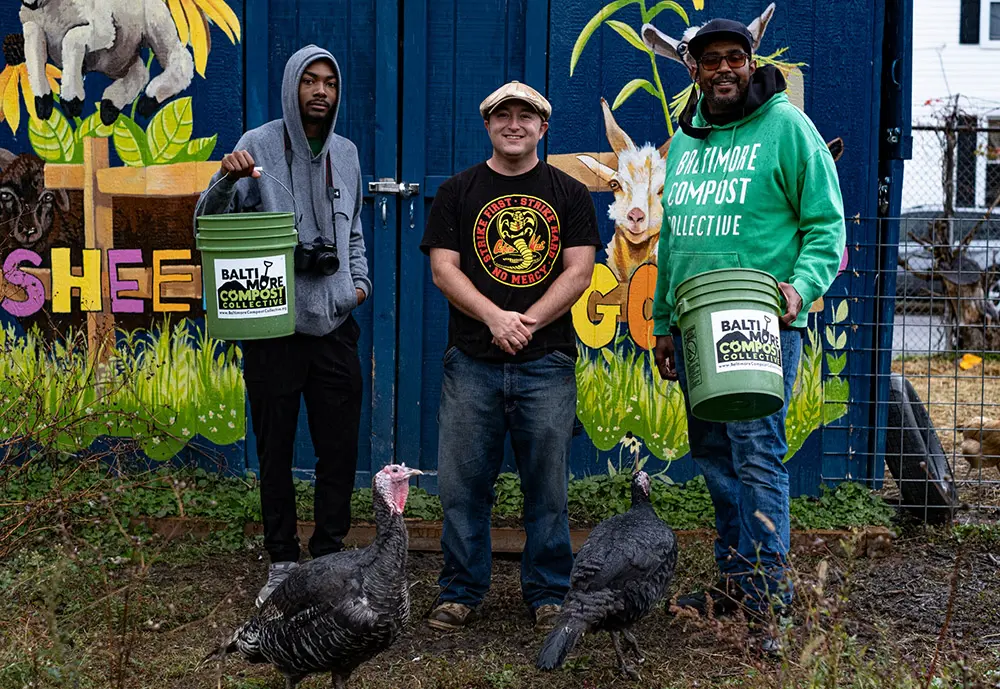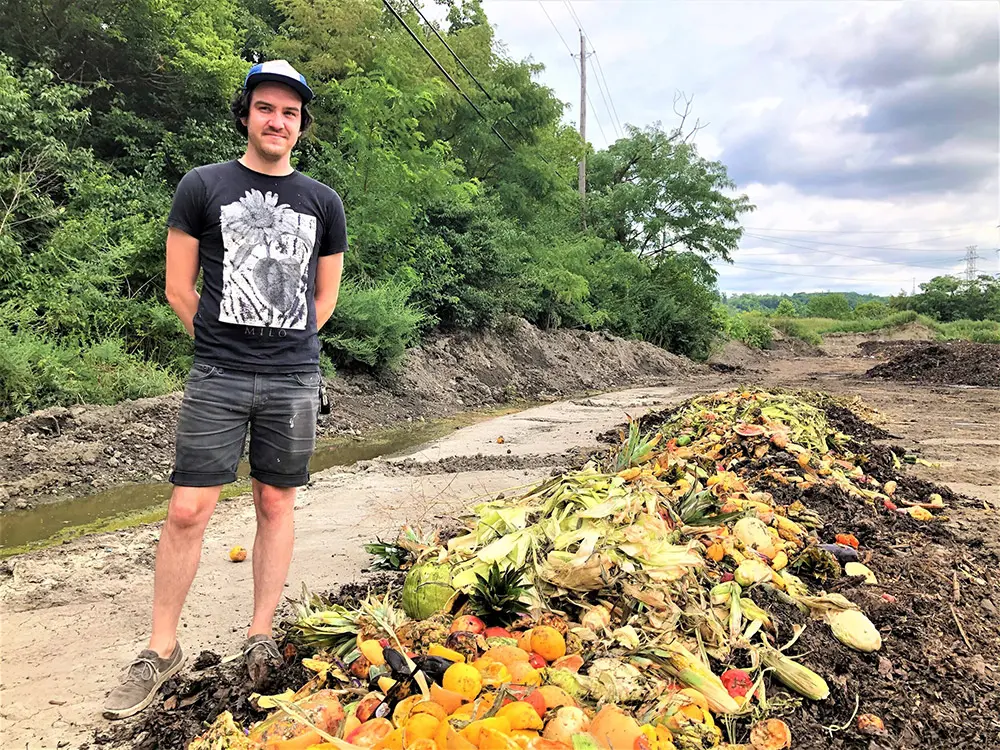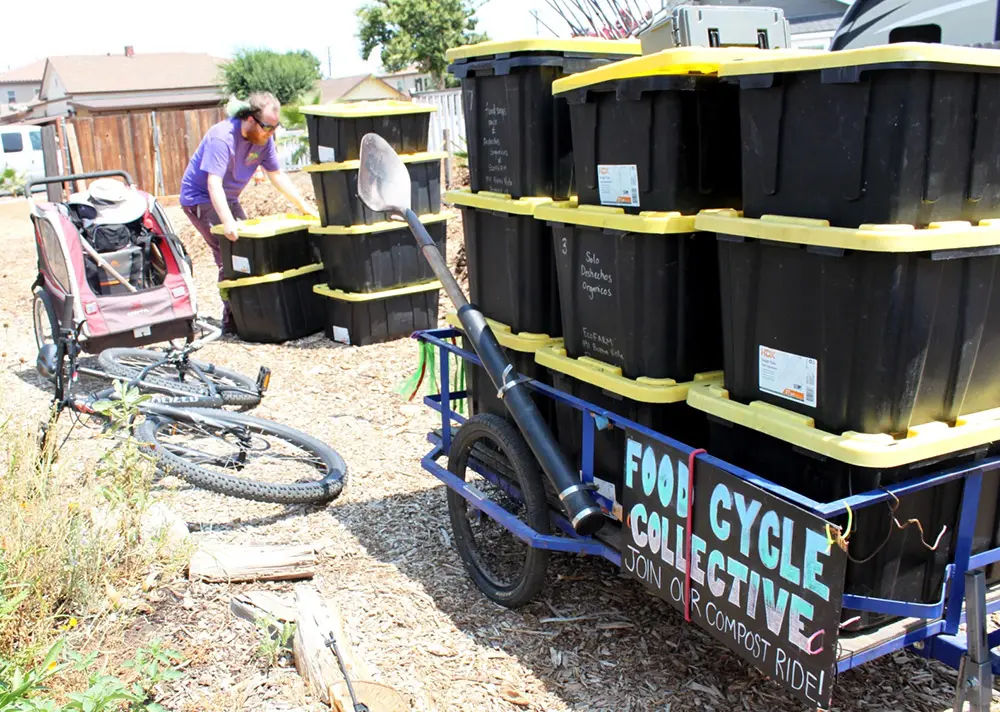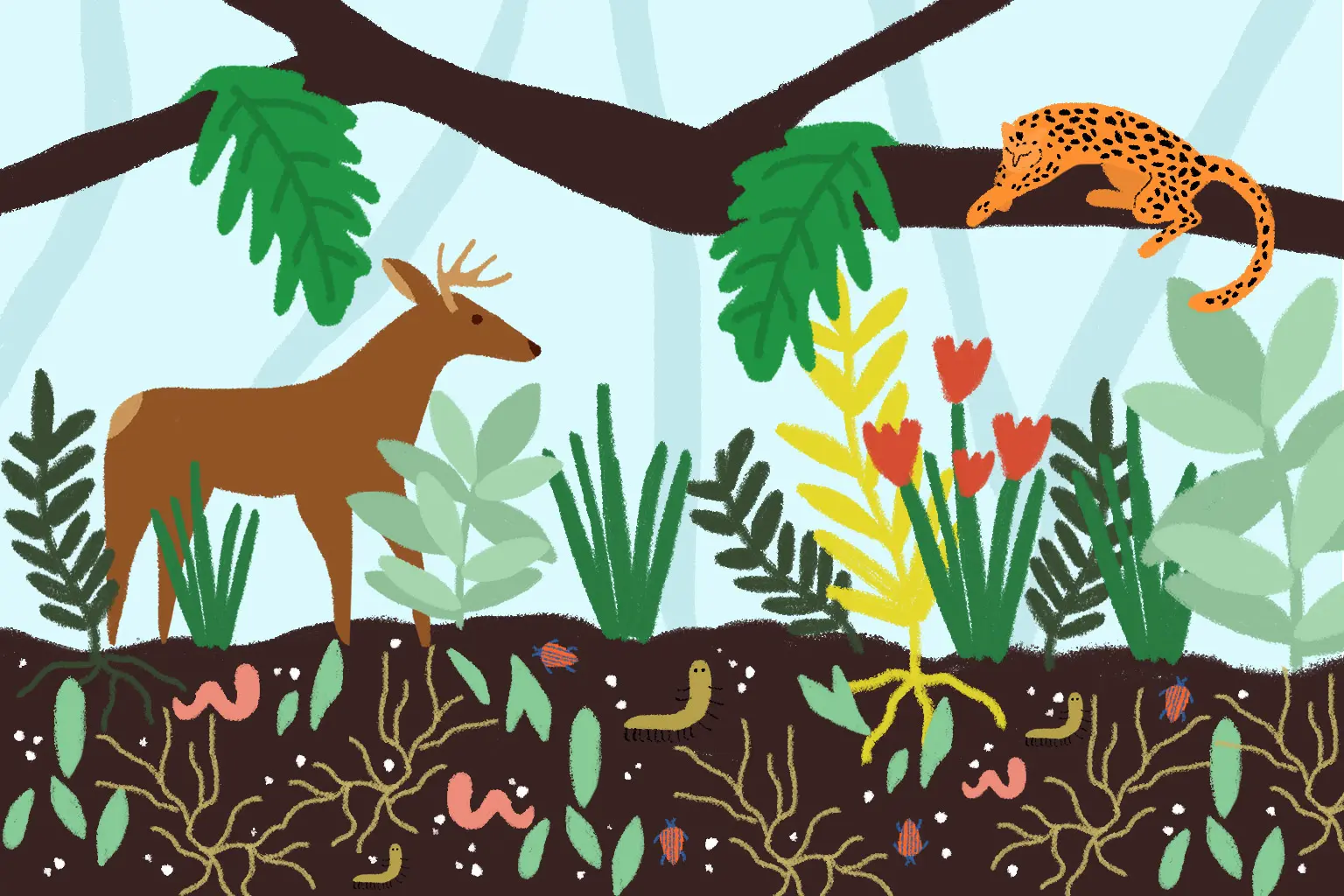Climate resilience as Community Composting
Community Composting is a powerful tool to:

Compost is a dark, nutrient-rich material produced by the decomposition of organic materials. It’s typically made from a combination of nitrogen-rich “green matter,” like food scraps, coffee grounds, garden trimmings or manure, and carbon-rich “brown matter,” like wood chips, dried leaves, straw, hay, or cardboard. When water and air are added, decomposers like insects, fungi, and bacteria are able to break down and transform the organic material. Sometimes dubbed “black gold,” quality compost is extremely helpful in supporting soil health and plant growth.
Community composting refers to a hyperlocal, participatory, and deeply intentional composting practice and movement that is quickly growing. While community composting efforts manifest in many ways, from bike-powered cooperative businesses to educational programs in school gardens, they’re unified by a common ethos. The Institute for Local Self-Reliance, which has become a national hub for community composting efforts, defines the guiding principles of community composting as follows:
- Food scraps and other organic materials are diverted from landfills;
- Organic materials are valued as a community asset;
- Finished compost is used to enhance local soils, support local food production, or support natural ecology;
- Compost systems are community-scale and are designed to meet the needs of a self-defined community (which might be 10 blocks in a dense city or a 50 mile radius in a rural area);
- The program should engage and educate the community; and
- The program should be supported by the community it serves and should serve the community in turn.
At the core of any community composting program is the principle of using previously wasted resources as community assets and reinvesting them back into the community that created them. Dustin Fedako, Compost Pedallers founder (source)
A brief history: For good reason, communities around the world have been returning nutrients to the land and growing food with the assistance of compost for millennia. In fact, archaelogical evidence suggests that Scots in the British Isles were creating compost heaps from their domestic waste to amend the soil of their small-scale farms as far back as 12,000 years ago. In Egypt, where it appears that people began adding a mixture of manure and straw to their fields around 3,000 B.C., legend has it that Queen Cleopatra recognized the invaluable role that earthworms played in the decomposition process and wanted to safeguard the fertility of the Nile River Valley at all costs. She therefore decreed that no one, including farmers, was allowed to touch the earthworms! Across Turtle Island, Indigenous peoples planted fish and other animal parts alongside seeds, balled seeds in clay and organic material, and practiced a method of composting now known as sheet mulching. In West Africa, women began creating what’s now known as “African dark earth”by combining ash and char, bones from food preparation, harvest residues, and more to create an incredibly nutrient-rich soil that stores up to 300% more organic carbon than other soils. The list goes on! Composting is an ancestral practice that land-based cultures have stewarded through history and continue to utilize today.
Continue readingWhy it’s a climate resilience powerhouse:
Restoring soil and watershed health
When the compost process and product are kept as local as possible, communities reap the benefits of improved soil health, flourishing plant life, and greater resilience to extreme weather. Because compost helps to build soil structure and support robust microbial processes underground:
- Soil amended with even a small amount of compost is much better equipped to conserve water during periods of drought and absorb water during heavy rainfall. Compost can actually hold up to 20 times its weight in water, so for each percentage of organic matter added to soil, the land is able to store 16,000 gallons more water per acre!
- Amending soil with compost can increase resistance to erosion and sediment-carrying runoff by as much as 50%! Therefore, compost helps to minimize landslides and waterway pollution when it rains.
- Microbe-rich compost is also effective at filtering out, binding, and breaking down toxins and pollutants, which means that it can help to remediate contaminated soil and improve water quality.
- Soil amended with compost supports larger, stronger trees and root systems, so they can better withstand extreme weather and provide ample shade amidst hot temperatures.
Continue reading
Supporting and closing the loop on flourishing food systems
Nutrient-rich compost both helps to produce more bountiful crop yields and reduces the need for polluting and expensive agricultural inputs (like fertilizers, pesticides, and other agrochemicals) and water. Unlike agrochecmicals, compost (1) can be produced nearby or onsite, at no or low cost; (2) doesn’t contribute to nutrient pollution of waterways because nutrients in compost slow-release into the soil, and; (3) doesn’t expose expose farmers and surrounding communities to toxic chemicals linked to both acute and chronic health impacts. Because compost is so effective at retaining water, soil amended with the organic material can also lower irrigation requirements by up to 50% in the summer! When gardeners and farmers utilize compost to grow food, they can save money, become less reliant on multinational agrochemical and biotechnology corporations, and move into greater harmony with local ecosystems.
Continue readingWe know that our work, composting, is often perceived to be at the end of the food system. But we actually see our work as the beginning of a local and very valuable nutrient and resource cycle. (source)
Mitigating greenhouse gas emissions and local air pollution:
Food waste is a major contributor to the climate crisis. More than a third of the food supply in the so-called United States goes to waste (a staggering number, particularly given that more than 10% of US households are affected by food insecurity) and about 95% of that waste ends up in the landfill or incinerated. When food rots in landfills, it generates methane, a seriously potent greenhouse gas that is 25 times more efficient at trapping heat than carbon dioxide over a 100-year period. The garbage hauling trucks that transport food waste to landfills are greenhouse gas intensive, too, and communities where waste transfer stations and waste facilities are concentrated (generally low-income and predominantly BIPOC communities) are disproportionately exposed to diesel pollution, which is linked to high rates of asthma, respiratory diseases, cardiovascular disease, and cancer. Incinerators, which are also most often located in low-income and predominantly BIPOC communities, are known to release many harmful air pollutants, like lead, mercury, dioxins, and particulate matter. The emissions generated by burning trash have been linked to respiratory illness, cardiac disease, and reproductive, developmental, and neurological problems.
So, when communities divert food from landfills and incinerators and instead transform it into compost, they’re meaningfully reducing methane emissions and helping to take garbage hauling trucks off the road and prevent new landfill and waste facility projects. Compost applied to the land also helps to actively sequester carbon! Community composting is a real win for both climate justice and environmental justice.
Food waste is responsible for 8% of global greenhouse gas emissions. (source)
Continue readingFood waste is responsible for 8% of global greenhouse gas emissions. (source)
Creating good jobs and other empowering opportunities
Community composting programs create good jobs (on a per ton basis, composting actually employs two times more people than landfills and four times more people than incinerators!) and meaningful volunteer opportunities. Many initiatives are also designed to center training and education, youth involvement, and connection to the land and one another. And whether folks are working, volunteering, attending the occasional workshop, or dropping off food waste, engaging in a community composting program can be a deeply empowering experience; it’s an accessible way for people to create something of value for their community with their own hands and participate directly in a climate resilience, justice, and adaptation solution.
“Community composting is the opposite of NIMBY, not in my backyard. It’s sort of like only in my backyard. Let me take responsibility for that, in my backyard, in my community.” – organizer Elinor Crescenzi (source)
Continue reading
Community composting is the opposite of NIMBY, not in my backyard. It's sort of like only in my backyard. Let me take responsibility for that, in my backyard, in my community. Elinor Crescenzi, Organizer (source)
The nuance / caveats:
It should be noted that community compost programs alone should generally not be expected to meet the scale of food waste generated locally, at least without adequate investment in these programs. Composting also shouldn’t be viewed as the singular solution to food waste; reducing surplus food and recovering food that can still be eaten should be the first priorities.
Continue readingSpotlights

BK ROT is a North Brooklyn-based bike-powered, youth-powered organic waste hauling and composting service. In a community impacted by rapid gentrification and environmental racism (and, specifically, a high concentration of waste transfer stations), BK ROT’s goal is to retain ecological, financial, and human resources within the neighborhood, and also to help address the enormous challenge of food waste in NYC. BK ROT hires young folks from the neighborhood, generally ages 17-24, to haul food waste from small businesses and homes back to their composting site in Bushwick via bike, and then help to transform the community’s food waste into high-quality compost. Compost is distributed locally to community gardens, urban farms, and other food-growing and soil-building projects. The model works. BK ROT has found that there’s a huge demand for their service from small local businesses who are eager to compost and reinvest locally, and there’s also a huge demand for good jobs that pay young people a living wage to be stewards of their community’s health. Thus far, they’ve diverted nearly a million pounds of food waste from the landfill and have produced nearly half a million pounds of high quality compost. Watch this short video produced by Vocativ and this short video produced by Robin Greenfield to learn more.
Support BK ROT by making a donation or, if you’re located in North or Central Brooklyn, utilizing their sliding-scale services; sign up for home pick-up or small business pick-up, learn more about food scrap drop-off options, or purchase their compost!
“What’s exciting about this work is that we have an opportunity to address food waste in a way that also addresses other social and environmental challenges. And BK ROT has demonstrated that composting can accomplish more than just waste diversion. It can create well-paying, accessible, meaningful, good green jobs. It can support urban food systems. It can reduce the use of diesel trucks in waste hauling. And it can strengthen local economies. Our model works.” - founder of BK ROT Sandy Nurse (source)
Continue reading about Community Composting
Baltimore Compost Collective was inspired by BK ROT and launched with support from the Institute for Local Self-Reliance Neighborhood Soil Rebuilder training program. Founder Marvin Hayes explains that he created Baltimore Compost Collective to “starve the incinerators and feed our communities”; South Baltimore’s Curtis Bay is impacted by food insecurity and toxic air pollution (the community is surrounded by two trash incinerators, a landfill, freeway, chemical company, and coal plant). Similar to BK ROT, Baltimore Compost Collective employs local young people and trains them in workforce skills, food access programming, and community scale composting. They collect food scraps from residents and businesses and bring them back to the Filbert Street Community Garden in Curtis Bay, or as Hayes calls it, “Wakanda of South Baltimore.” The one-acre garden used to be a vacant lot where people dumped their trash, and now it supports food production, urban wildlife, youth education, and a robust compost program. Baltimore Compost Collective also prioritizes environmental justice advocacy and has the first electric bike-powered compost fleet in the country (learn more about that here).
Support Baltimore Compost Collective by making a donation or, if you’re local to South Baltimore, volunteering and/or signing up for curbside food scrap pick-up or business food scrap collection.
Continue reading about Community Composting
Rust Belt Riders is a Cleveland-based workers’ cooperative with the mission of “feeding people, not landfills.” The social enterprise was founded by Daniel Brown and Michael Robinson when Brown was both working at a restaurant, witnessing how much food got wasted, and starting a community garden. Robinson, meanwhile, was musing about how awesome it would be if Cleveland had a cooperative working to make more resilient food systems and also build climate resilience in the region. When Brown and Robinson began Rust Belt Riders, they were collecting food scraps from restaurants and bringing them to community gardens via mountain bike and a bike trailer. Years later, they’ve expanded to serve thousands of households (this number grew dramatically during the pandemic), over 200 restaurants, grocers, businesses, and institutions (like Cleveland State University), and they ship their compost-rich Tilth Soil nationwide. In 2022 alone, they composted 6.8 million pounds of food waste, and they’re on track to compost 10.4 million pounds in 2023.
You can support Rust Belt Riders by purchasing their compost-rich Tilth Soil or, if you’re located in Northeast Ohio, utilizing their services; sign up for home pick-up or drop-off, or explore their commercial hauling services if you’re affiliated with a business that generates food waste.
Continue reading about Community Composting
Food2Soil is a San-Diego based social enterprise that “aims to be the Airbnb of community composting—a network so expansive that anyone can find a place to drop off their food scraps and Soil Farmers can earn an income accepting food scraps and building compost.” Founder Sarah Boltwala-Mesina explains, “We envision a network where every zip code has a drop-off location, and compost is built where food is consumed.” Since Food2Soil was founded in 2015, it has evolved into a decentralized, people-powered network of 24 drop-off hubs, 12 Soil Farmers, and hundreds of subscribers. The organization allows households and businesses to pay for a subscription for regular food scrap pick-up, or they can pay a small fee for each bucket of food scraps that they drop off themselves. Every participant has access to free “all you can sift” compost for their gardens. Local and regional policy advocacy has also been a focus for Food2Soil; since most cities in the County of San Diego have an exclusive franchise agreement with waste haulers, it makes it really difficult for community composters to navigate how to do their work. They’re working to eliminate roadblock policy and defend their community’s right to compost.
You can get engaged with Food2Soil by participating in their dropoff program if you’re local to San Diego.
Continue reading about Community CompostingFood Cycle Collective is a Pomona, California-based volunteer-run, grassroots group that collects food waste from households and businesses and delivers it to urban farms, primarily by bike. The group was founded in 2020 and is rooted in principles of mutual aid, reciprocity, and respect. One of the primary sites where they deliver food scraps is a half-acre community garden in South Pomona, also maintained by Food Cycle Collective volunteers and other local groups, where anyone in the neighborhood can harvest the food for free. They host regular group biking “joyrides” that are not just about taking food waste from point A to point B, but are also meant to cultivate relationships with one another and neighbors in the community, as well as to provide care for and deliver resources to unhousehed neighbors.
Follow their Instagram page for opportunities to engage with the Food Cycle Collective community!
Continue reading about Community CompostingResearch + reflection prompts:
- Are there any composting programs already in existence or emerging in your area? Do any of the programs appear to be algiend with the community principles outlined by the Institute for Local Self-Reliance?
- Which organizers are working hard to advance the composting movement in your community?
- If you can’t find any composting projects in your area, might policy-related barriers be a factor?
- There are countless lessons to be gleaned from the composting process. What have you previously viewed as disposable that you’d like to reframe and reclaim as an asset? The practice of composting is a sacred ritual of decomposition from which new life emerges; what systems, paradigms, or mindsets would you like to see decay and decompose to make way for the new? How might you help nourish this process?
How to get engaged:
Contribute food waste
If there are already community composting efforts underway in your area: Get involved by contributing your food waste (hot tip: consider storing your kitchen scraps in an airtight container in your freezer until you’re ready to drop it off; this will help to prevent stinkiness!) and/or volunteering to help with food scrap pick-up, compost pile maintenance, or community outreach. Explore the Institute for Local Self-Reliance’s Composting for Community Map and the membership directory of the Community Composter Coalition to find community composting projects happening near you! Check out local farmers markets and community gardens, too; many have collection programs for food scraps.
Community composting program
If you’re passionate about composting and you have the bandwidth: Help to start a community composting program in your neighborhood. If you’re involved with a school, community garden, or nearby farm, that can be a great place to start. Check to see if there are any community compost grant programs available in your municipality or state. Consider how existing rules and regulations might affect your operation, which sites might work best, who will be involved and how you’ll engage your community, which benefits you’ll be maximizing for (like education, soil improvement for local farms, waste diversion, local job creation, etc.), where you’ll be sourcing composting materials, where finished compost will go, and how it will all be transported. Try to connect with folks who have engaged in community compost efforts elsewhere. Start small.
Home compost system
If you have access to land: Begin a compost system at home. Since composting is most efficient with more material, talk to your neighbors about combining materials to produce compost together.
Compost advocacy
If there are policy-related barriers to composting in your community: Become a composting advocate. Contact your local planners and elected officials and attend town meetings to call for funding, technical assistance, training, and long-term land access for community composting programs, as well as the amendment of any unnecessary policies and regulations that make it difficult for community composting programs to operate. The Institute for Local Self-Reliance’s Composting Rules Library and Composting for Community Map of local and state policies and programs are great places to get started.
General best practices
Former executive director of BK ROT Ceci Pineda says, “Seek out neighbors to work on things together. Find spaces where this work is already underway and where you might be comfortable getting engaged. Don’t get discouraged; if one space isn’t right for you, there are others that will hold you. There are so many people who desire this connection and who are nourishing this connection. And the earth is everywhere around us. The land is always calling us back. It’s about listening to that calling and also being a little courageous to try new things.”
A smattering of resources for continued learning + action:
Short Reads
- “The Green, Brown, and Beautiful Story of Compost” by Aaron Sidder in National Geographic
- “The community composting movement: how to make a closed-loop food-and-waste system sexy” by James McSweeney in GreenBiz
- “Community Composting 101: Don’t Let Your Food Waste Go To Waste” by Jessica Langlois in LAist
- “His vision for community buy-in on composting; Make it ‘cool’” by Anna Deen in Grist
- “How One Person’s Small, Brave Compost Pile Changed New York City” by Colin Beavan in Yes Magazine
- “The Gift of Soil: How Composting Builds Community: The perfect soil mixture can do more than grow food” by Liz Brazile in Yes Magazine
- “Community Composting Grows from a Seed into a Movement” by Cat Johnson in Shareable
Reports and Guides
- Growing Local Fertility: A Guide to Community Composting by the Highfields Center for Composting and the Institute for Local Self-Reliance
- Community Composting Done Right: A Guide to Best Management Practices by Linda Bilsens Brolis and Brenda Platt and the Institute for Local Self-Reliance
- NYC Master Composter Manual by NYC Compost Project
- “How to start a community composting project” by Brenda Platt in Shareable
- “How to start and run a community compost site” by Robin Greenfield
Long Reads
- Community-Scale Composting Systems: A Comprehensive Practical Guide for Closing the Food System Loop and Solving Our Waste Crisis by James McSweeney
- Farming While Black by Leah Penniman
- Let it Rot!: The Gardener’s Guide to Composting by Stu Campbell
Watch
- Community Composting Webinar Series: a video series by the Institute for Local Self-Reliance to offer guidance to community-scale composters on best management practices, business models, navigating legal and policy hurdles, and more.
- Treasure, not Trash: Composting and Food Recovery is Good for Communities: a 15-minute TEDx talk about the benefits of composting on communities and larger society
- Wasted! The Story of Food Waste: a 2017 documentary directed by Anna chai and Nari Kye and produced by the late celebrity chef Anthony Bourdain (and others) exploring the food waste epidemic and some of its solutions
Listen
Engage More Deeply
- If you’re interested in building your community composting skills and confidence and have a few hours to spare, consider the Community Composting 101 Online Certificate Course by Institute for Local Self-Reliance
- Sign up for a Master Composter Course! They’re often offered through college extension programs for local residents, botanical gardens, Master Gardener Societies, and parks departments.







